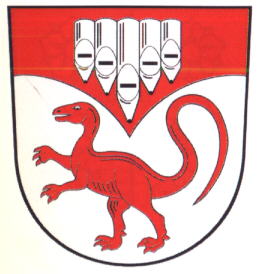Bedheim: Difference between revisions
Jump to navigation
Jump to search
Knorrepoes (talk | contribs) No edit summary |
Knorrepoes (talk | contribs) m (Text replace - "[[Literature" to "{{media}} [[Literature") |
||
| Line 22: | Line 22: | ||
The dinosaur (<I>Liliensternus</i> (formerly <i>Halticosaurus</I>) <I>liliensterni</I>) is used as in the Kleine Gleichberg remains of this species were found by the local doctor Hugo Rühle von Lilienstein in 1934. The colours are those of the Lords of Hessberg, who had their estate in the village for many centuries. | The dinosaur (<I>Liliensternus</i> (formerly <i>Halticosaurus</I>) <I>liliensterni</I>) is used as in the Kleine Gleichberg remains of this species were found by the local doctor Hugo Rühle von Lilienstein in 1934. The colours are those of the Lords of Hessberg, who had their estate in the village for many centuries. | ||
{{media}} | |||
[[Literature]] : Ulle, 1998 | [[Literature]] : Ulle, 1998 | ||
Revision as of 18:40, 8 July 2014
| Heraldry of the World Civic heraldry of Germany - Deutsche Wappen (Gemeindewappen/Kreiswappen) |
BEDHEIM
State : Thüringen
District (Kreis) : Hildburghausen
Incorporated into : 1993 Gleichamberg (2012 Römhild)
Official blazon
Origin/meaning
The arms were granted on January 5, 1993.
The organ pipes in the upper half symbolise the unique organ, built in the local church in 1721 by order of Philipp von Hessberg.
The dinosaur (Liliensternus (formerly Halticosaurus) liliensterni) is used as in the Kleine Gleichberg remains of this species were found by the local doctor Hugo Rühle von Lilienstein in 1934. The colours are those of the Lords of Hessberg, who had their estate in the village for many centuries.
Contact and Support
Partners:
Your logo here ?
Contact us
© since 1995, Heraldry of the World, Ralf Hartemink 
Index of the site
Literature : Ulle, 1998











